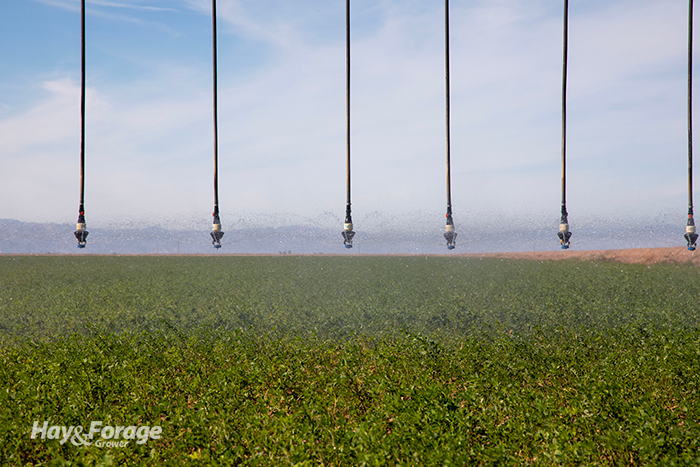
Alfalfa has a lot of impressive features when it comes to water usage. And despite being a major water user, alfalfa is also a major food producer. At least, that is how Dan Putnam defended the number one field crop in the Golden State against claims of water overconsumption at the California Alfalfa & Forage Symposium last month in Sparks, Nev.
At the symposium, Putnam explained alfalfa’s value as a productive and flexible water consumer. The extension professor emeritus with the University of California, Davis, contended that deficit irrigation — not fallowing or eliminating alfalfa stands — may be the best tool to address the water crisis in regions where robust forage production occurs in the West and water availability is highly variable.
Conversations surrounding water usage in the Colorado River Basin have been ongoing since the signing of the Colorado River Compact in 1922, which was the first document to define how much water each of the seven states in the basin would receive. Arizona, California, Colorado, Nevada, New Mexico, Utah, and Wyoming all have skin in the water allocation game, but Putnam purported the first two states on this list typically boast the longest and warmest growing seasons, putting them in position to be the greatest consumers of water for alfalfa.
In Arizona and southern California, Putnam estimated about 41% of total water is used to irrigate forage crops, with about 25% used for alfalfa. That pencils out to about 12 million acre-feet of water per year being administered to alfalfa fields. This number can seem especially daunting during drought years when water reservoirs dip below sustainable levels; however, Putnam argued drought is not necessarily the driver of water scarcity in the desert Southwest. Rather, it’s long-term variation in water availability and the inability to capture it during wet years.
“Our lack of high water flow capture is one of our major limitations,” he said.
In addition to inadequate storage, Putnam noted the ever increasing demand for water from sectors other than agriculture. As city populations grow and more water is preserved for environmental reasons, demand constantly exceeds supply, putting more eyes on the amount of water that continues to be used for forage production. With that said, alfalfa has several attributes that may make it a solution to water scarcity instead of a public enemy.
Alfalfa’s attributes
For one, alfalfa has a high capacity for water conductivity, which means it can produce more tons of dry matter per unit of water compared to many other species.
“Deep roots are another feature of this crop,” Putnam stated. “It starts growing right away in the spring, and you don’t have to reestablish it with irrigation water like you do with other annual crops.”
Deep taproot systems — which have been documented as deep as 15 feet in California’s Imperial Valley — also enable alfalfa to access residual water, which may be left over in the soil from earlier irrigation events. Further, it can also accept degraded water, such as water that is high in salt or that from saline soils. Most high-value orchard crops that are grown throughout the Golden State are less tolerant to lower quality water.
This flexibility as a water consumer makes it a good candidate for deficit irrigation. Putnam alluded to alfalfa’s point of origin in the Middle East where it was adapted to a hot, dry climate. Thus, the short-term perennial has the genetic capacity to respond to and overcome water deficits.
In low desert regions, alfalfa growers can routinely achieve nine alfalfa cuttings per year, if not more, and research shows 75% to 80% of alfalfa production there takes place before mid-August. This is when partial-season deficit irrigation programs would likely begin, striking a balance between achieving the majority of total-season yield and saving significant water resources during the hottest, driest time of year.
Putnam suggested partial-season dry down is more practical than season-long starvation irrigation regimes. The former ensures plants receive full water at the start of the season to promote better production when yield potential is highest and then turning off irrigation when forage growth is inherently slower.
“We want to see the soil profile filled early to take advantage of those winter rains and early, cooler conditions,” Putnam said. “Provide full irrigation to a cut-off point and then go cold-turkey.”
Consumer value
While deficit irrigation makes sense from an agricultural standpoint, the challenge lies in convincing the public of alfalfa’s economic value. Putnam said this is especially difficult as alfalfa has relatively zero value to consumers.
“[Alfalfa] doesn’t have a consumer value until you link it with food production,” he asserted. This primarily includes dairy production, which is the number one agricultural output in California. Putnam continued to note that nutritionists have calculated roughly 2,500 to 3,000 gallons of milk equivalent are produced per acre of alfalfa. Therefore, he suggested fallowing or eliminating alfalfa fields would have a much greater ripple effect on human food supply than many people may realize.
To illustrate how dairy demand affects the value of alfalfa, Putnam estimated the economic consumer value of several grocery store items: a loaf of bread, a bag of rice, a container of almonds, and a gallon of milk. Considering the daily demand for dairy, a gallon of milk had similar consumer value as a container of almonds, despite the latter item posting a much greater unit cost.
Moreover, Putnam noted the environmental benefits that are preserved when alfalfa fields are allowed to stay in production under deficit irrigation. Were stands to be fallowed or eliminated altogether, so would the ecosystem services alfalfa provides above and below the soil surface.
“We need to maintain the benefits these cropping systems have on soils, wildlife, the community, and the economy,” Putnam said.

